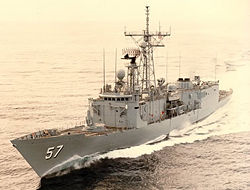Oliver Hazard Perry-class: Difference between revisions
imported>Howard C. Berkowitz |
mNo edit summary |
||
| (3 intermediate revisions by 3 users not shown) | |||
| Line 1: | Line 1: | ||
{{subpages}} | {{PropDel}}<br><br>{{subpages}} | ||
'''Oliver Hazard Perry''' class warships are active in the [[United States Navy]] and other navies. Functionally, they are | {{TOC|right}} | ||
'''Oliver Hazard Perry''' class warships are active in the [[United States Navy]] and other navies. Functionally, they are ocean escorts, primarily for [[anti-submarine warfare]] with a local and limited [[anti-air warfare]] and [[anti-surface warfare]] capability. They serve in [[amphibious warfare]] and as escorts for [[replenishment ship]]s, as well as for [[protection of shipping]]. | |||
[[Image:USS Reuben James (FFG-57).jpg|left|250px|thumb|''USS Reuben James'' (FFG-57)]] | |||
Designed as cost efficient surface combatants, they lack the multi-mission capability necessary for modern surface combatants faced with multiple, high-technology threats. They also offer limited capacity for growth. Despite this, the FFG 7 class is a robust platform, capable of withstanding considerable damage. This "toughness" was aptly demonstrated when [[USS Samuel B. Roberts (FFG-58)|''USS Samuel B. Roberts'' (FFG-58)]] struck a mine and [[USS Stark (FFG-31)|''USS Stark'' (FFG-31)]] was hit by two [[Exocet]] cruise missiles. In both cases the ships survived, were repaired and returned to the fleet. USS Stark was decommissioned in May 1999. | |||
The lead ship of the class, [[USS Oliver Hazard Perry (FFG-7)|''USS Oliver Hazard Perry'' (FFG-7)]] and the following ships have been decommissioned: FFG 9-16, 19-27, 30, 31, & 34. | |||
The lead ship of the class, USS | |||
Current Navy plans do not call for a replacement of these limited-capability ships. Where greater capability is needed, [[Burke-class]] [[destroyer]]s are immensely more capable, although more expensive. The Perry class was optimized for blue water escorting during the [[Cold War]], which is no longer a major mission; [[Littoral Combat Ship]]s are more appropriate for escorting in confined waters. | |||
==Sensors== | |||
==Weapons== | |||
Long-range [[surface-to-air missile]] launchers have been removed from U.S. vessels, since the limited supply of SM-1 missiles was more needed by allies. | |||
==Sales== | ==Sales== | ||
FFG 17, 18, 35, & 44 were built for Australia | FFG 17, 18, 35, & 44 were built for Australia, and named ''Adelaide'', ''Canberra'', ''Sydney'' and ''Darwin''. Australia has since built two more of the class, ''Melbourne'' and ''Newcastle''. Other nations operating the Oliver Hazard Perry-class include Spain, Taiwan, Turkey, Egypt, Bahrain and Poland. | ||
==General characteristics== | ==General characteristics== | ||
| Line 30: | Line 32: | ||
**Aircraft | **Aircraft | ||
***Two SH-60 (LAMPS III) in FFG 8, 28, 29, 32, 33, 36-61 | ***Two SH-60 (LAMPS III) in FFG 8, 28, 29, 32, 33, 36-61 | ||
***One SH-2 (Lamps Mk-I) in FFG 9-19, 30, 31. | ***One SH-2 (Lamps Mk-I) in FFG 9-19, 30, 31.[[Category:Suggestion Bot Tag]] | ||
Latest revision as of 11:00, 28 September 2024
| This article may be deleted soon. | ||
|---|---|---|
Oliver Hazard Perry class warships are active in the United States Navy and other navies. Functionally, they are ocean escorts, primarily for anti-submarine warfare with a local and limited anti-air warfare and anti-surface warfare capability. They serve in amphibious warfare and as escorts for replenishment ships, as well as for protection of shipping. Designed as cost efficient surface combatants, they lack the multi-mission capability necessary for modern surface combatants faced with multiple, high-technology threats. They also offer limited capacity for growth. Despite this, the FFG 7 class is a robust platform, capable of withstanding considerable damage. This "toughness" was aptly demonstrated when USS Samuel B. Roberts (FFG-58) struck a mine and USS Stark (FFG-31) was hit by two Exocet cruise missiles. In both cases the ships survived, were repaired and returned to the fleet. USS Stark was decommissioned in May 1999. The lead ship of the class, USS Oliver Hazard Perry (FFG-7) and the following ships have been decommissioned: FFG 9-16, 19-27, 30, 31, & 34. Current Navy plans do not call for a replacement of these limited-capability ships. Where greater capability is needed, Burke-class destroyers are immensely more capable, although more expensive. The Perry class was optimized for blue water escorting during the Cold War, which is no longer a major mission; Littoral Combat Ships are more appropriate for escorting in confined waters. SensorsWeaponsLong-range surface-to-air missile launchers have been removed from U.S. vessels, since the limited supply of SM-1 missiles was more needed by allies. SalesFFG 17, 18, 35, & 44 were built for Australia, and named Adelaide, Canberra, Sydney and Darwin. Australia has since built two more of the class, Melbourne and Newcastle. Other nations operating the Oliver Hazard Perry-class include Spain, Taiwan, Turkey, Egypt, Bahrain and Poland. General characteristics
|
||
